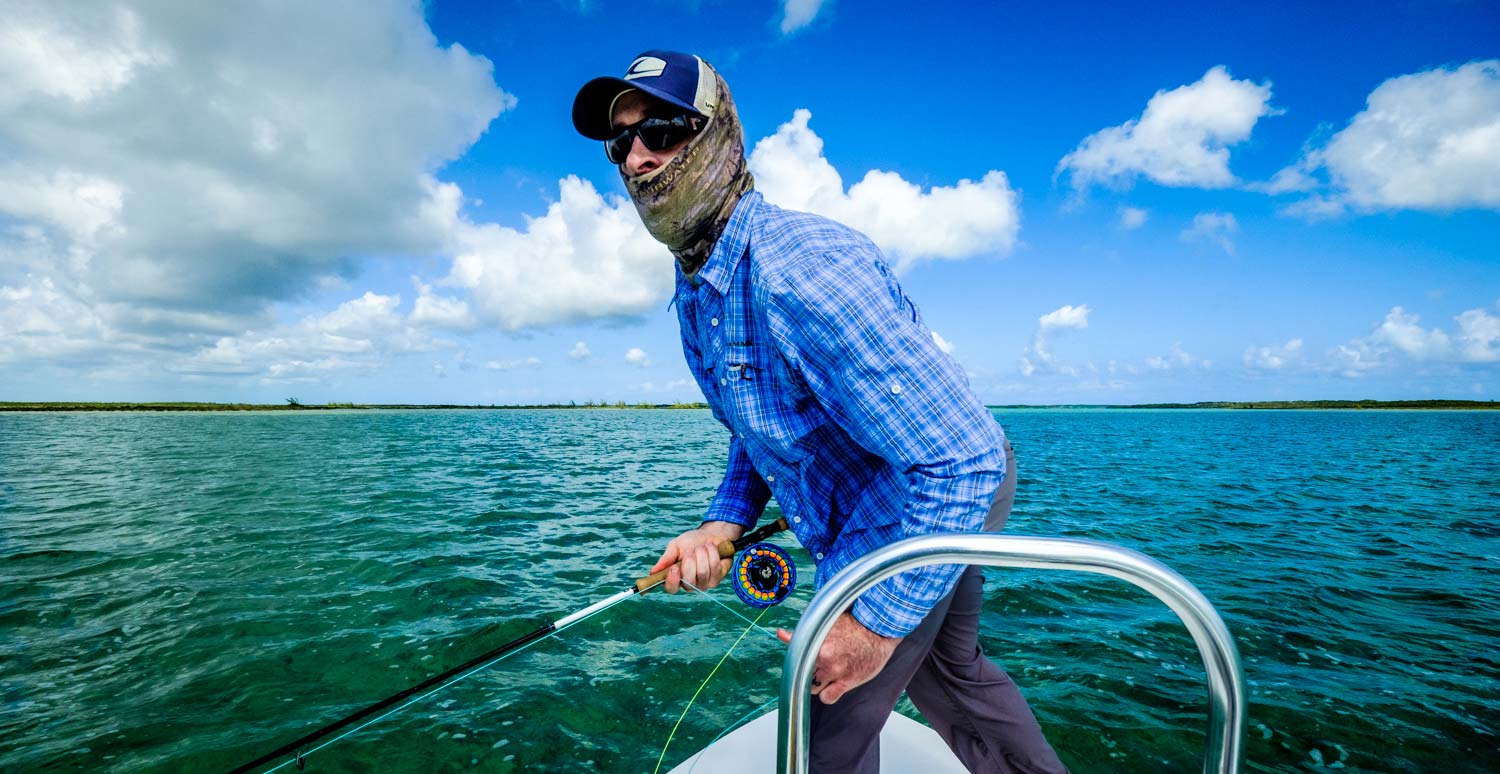
Bob Reece is frosty on the bow. Photo by Louis Cahill
By Louis Cahill
Fly-fishing saltwater flats requires many specialized skills, but none are as important as situational awareness.
Trout anglers revel in taking their time, analyzing the feeding patterns of fish and planning a successful presentation. That’s a luxury saltwater anglers can’t often afford. Things happen quickly on the flats, and it’s the prepared angler who catches fish. Flats fishing is hunting fish. Generally, the fish you are pursuing are hunting as well. They are constantly on the move and highly aware of changes in their environment. For every fish you see, there is a window of opportunity where you have a chance to make a good presentation. That window opens and closes quickly, and when it closes, it rarely opens again. An angler’s timing is often the single most important factor.
Standing on the bow of a skiff looks peaceful, and once you are comfortable with the process, it is. Below the surface, a good angler is keeping up with a laundry list of variables, planning, and calculating their best response to every possible scenario. Keeping up with current speed and direction, boat movement, water depth, lighting and the changing structure of the flat. When a fish appears, their may not be time to think about whether you should cast forehand or backhand, or how far you should lead the fish. You may need to react quickly and instinctively. It sounds more difficult than it is. With time it becomes second nature.
I spend a lot of time on the boat with anglers who are new to flats fishing.
The thing I see kill opportunities more than anything else is a lack of situational awareness. While keeping up with light and water movement is somewhat advanced skill, it’s the simple things that are the most common problems. Simple stuff like line management often spoils shot after shot. A guide told me last week that he had a client who had a thirty foot shot at a school of permit. The client false casted wildly with no idea that his fly was hooked in the stripping mat. Nobody wants to be that guy.
Another simple error I see ruin a lot of good shots is anglers who never move their fly. It sounds crazy but it happens with startling regularity. A fish appears, the angler makes the cast and starts to strip, anxiously waiting for the tug that never comes, because the fly is sitting dead on the bottom because the boat is moving toward the fly faster than they are picking up line. Then when the guide calls for another cast, the pickup is loud and spooks the fish, because of all the slack.
Often it’s as simple as having your fly and leader in good shape when it’s time to make the presentation. An angler may stand on the bow for twenty minutes with wind knots in their leader or trash on their fly. It’s too late to check your setup after a fish refuses the fly or breaks the leader. These kind of simple mistakes can be heartbreaking on days when opportunities are limited. Fortunately, they are easy to avoid by simply paying attention.
Here are 10 things you should always be aware of when fly fishing saltwater.
Use a good ready position and be meticulous about it. An angler in an effective ready position can cast a fly instantly to a fish that appears anywhere in their casting range.
Make a clearing cast and stack your line carefully. Keep the deck and cockpit clear of gear and shoes and keep an eye on you running line to keep it free and clear.
Fish barefoot or in socks so you can feel the line under your feet and eliminate the noise of shoes on the deck.
Treat your fly line with care. Keep it clean and never strip line off the reel perpendicular to the rod. The friction of the line against the frame of the reel will cause it to curl and tangle. Never kick your running line off the deck. It will roll under your foot and cause the line to curl.
Be careful, when retrieving the fly, not to drop your line off of the boat. Once it’s caught under the hull, your shot is over.
Always watch your fly line when retrieving your fly. If the line is slack on the water, your fly is not moving.
Check your fly and leader often. The time to fix wind knots, weak connections of fowled flies is always now.
Watch the fish’s body language. You may need to alter your retrieve or even the direction and distance of your cast accordingly.
Always listen to your guide. They may have information you do not.
Be aware of predators in the area. It hurts to lose a fish to a shark. It hurts more to lose a hand while releasing a fish.
Here are a couple of videos that may help.
Louis Cahill Gink & Gasoline www.ginkandgasoline.com hookups@ginkandgasoline.com Sign Up For Our Weekly Newsletter!

Pingback: Situational Awareness and Flats Fishing | Latest Fishing Blogs Posts
Instead of bare feet or socks, I wear surf boots (low rise, thin soles) when in the boat over a pair of polypro socks. The tops of my feet don’t get sunburned, I can still feel the fly line underfoot and I have some protection if I step on something in the boat.
If fishing over hard sand flats, you can even wear the surf boats to wade the flats.